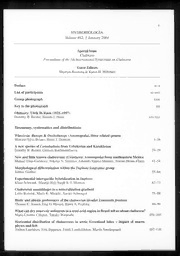Table Of ContentHYDROBIOLOGIA
Volume 442, | January 2001
Special Issue
Cladocera
Proceedings of the 5th International Symposium on Cladocera
Guest Editors
Maarten Boersma & Karen H. Wiltshire
Preface <x
List of participants XI-XVII
Group photograph XVill
Key to the photograph XiX
Obituary: Ulrik Ib Regen (1925-1997)
Dorothy B. Berner, Brenda J. Hann XXI—XXV
Taxonomy, systematics and distributions
Wlassicsia, Bunops & Onchobunops (Anomopoda), three related genera
Marcelo Silva-Briano, Henri J. Dumont 1-28
A new species of Ceriodaphnia from Uzbekistan and Kazakhstan
Dorothy B. Berner, Gulnara Rakhmatullaeva 29-39
New and little known cladocerans (Crustacea: Anomopoda) from southeastern Mexico
Manuel Elfas-Gutiérrez, Nikolai N. Smirnov, Eduardo Sudrez-Morales, Noemi Dimas-Flores
Morphological differentiation within the Daphnia longispina group
Sabine GieBler
Experimental interspecific hybridization in Daphnia
Klaus Schwenk, Maartje Bijl, Steph B. J. Menken
Cladoceran assemblages in a mineralization gradient
Loles Boronat, Maria R. Miracle, Xavier Armengol 75-88
Biotic and abiotic preferences of the cladoceran invader Limnosida frontosa
Thomas C. Jensen, Dag O. Hessen, Bjorn A. Faafeng 89-99
What can dry reservoir sediments in a semi-arid region in Brazil tell us about cladocera?
Maria Cristina Crispim, Takako Watanabe 101-105
Horizontal distribution of cladocerans in arctic Greenland lakes — impact of macro-
phytes and fish
Torben Lauridsen, Erik Jeppesen, Frank Landkildehus, Martin S@ndergaard 107-116
Vi
Zooplankton on the move: first results on the quantification of dispersal of zooplankton
in a set of interconnected ponds
Erik Michels, Karl Cottenie, Liesbeth Neys, Luc De Meester 117-126
Feeding, growth and reproduction
Study of the late embryogenesis of Daphnia (Anomopoda, ‘Cladocera’, Branchiopoda)
and a comparison of development in Anomopoda and Ctenopoda
Alexey A. Kotov, Olga S. Boikova 127-143
Intersex and male development in Daphnia magna
Suzanne E. Mitchell 145-156
Life-history variation related to the first adult instar in daphnids derived from diapaus-
ing and subitaneous eggs
Kestutis ArbaCiauskas 157-164
Reduction of the filtration rate of Daphnia galeata by dissolved photosynthetic products
of edible phytoplankton
Annekatrin Wagner, Norbert Kamjunke 165-176
Clearance rates and prey selectivity of the predaceous cladoceran Polyphemus pediculus
Anne T. Packard 177-184
Predator—prey interactions
The influence of fish kairomones on the induction and vertical distribution of sexual
individuals of the Daphnia galeata species complex
Piet Spaak, Maarten Boersma 185-193
The presence of fish induces the quick release of offspring by Daphnia
Andrzej Mikulski 195-198
Does trimethylamine induce life-history reactions in Daphnia?
Sandra Lass, Maarten Boersma, Karen Helen Wiltshire, Piet Spaak, Hinnerk Boriss 199-206
The effects of food and temperature regimes on life-history responses to fish kairomones
in Daphnia hyalina x galeata
Arve Dokseter, Jacobus Vijverberg 207-214
Daphnia galeata \ife history response to heterogeneous food conditions and dissolved
chemicals in the Rimov Reservoir
Jiri Machaéek
Predation on Daphnia pulex by Lepidurus arcticus
Kirsten Christoffersen
Foraging behaviour of planktivorous fish in artificial vegetation: the effects on swimming
and feeding
Tilak Priyadarshana, Takashi Asaeda, Jagath Manatunge 231-239
Predation and competition in zooplankton communities
Reproductive potential of Daphnia galeata in relation to food conditions: implications of
a changing size-structure of the population
Stephan Hiilsmann 241-252
Do fast increasing food conditions promote the midsummer decline of Daphnia galeata?
Hanno Voigt, Stephan Hiilsmann 253-259
The transfer of fatty acids in a freshwater planktonic foodweb of the Kuibyshevskoe
reservoir (middle reaches of the Volga)
Eugene A. Bychek, Irina A. Guschina 261-268
Carbon as an indicator of Daphnia condition in an alpine lake
Monika Winder, Piet Spaak 269-278
Competitive ability of Daphnia under dominance of non-toxic filamentous cyanobacteria
Rainer Kurmayer 279-289
Species-specific population-density thresholds in cladocerans?
Z. Maciej Gliwicz 291-300
Distribution patterns and predation risk of the coexisting cladocerans Bythotrephes
longimanus and Leptodora kindtii in a large lake - Lake Constance
Annette Palmer, Hans-Bernd Stich, Gerhard Maier 301-307
Did chironomid emergence release Daphnia from fish predation and lead to a Daphnia-
driven clear-water phase in Lake Towada, Japan?
Wataru Makino, Hideo Kato, Noriko Takamura, Hitoshi Mizutani, Noboru Katano, Hajime
Mikami 309-317
Seasonal dynamics of metabolic activity of the Daphnia community in Lake Bled
(Slovenia)
Tatjana Siméi¢, Anton Brancelj 319-328
Fish and crustaceans in northeast Greenland lakes with special emphasis on interactions
between Arctic charr (Salvelinus alpinus), Lepidurus arcticus and benthic chydorids
Erik Jeppesen, Kirsten Christoffersen, Frank Landkildehus, Torben Lauridsen, Susanne L.
Amsinck, Frank Riget, Martin Sondergaard 329-337
Zooplankton community structure and environmental conditions in a set of interconnec-
ted ponds
Karl Cottenie, Nele Nuytten, Erik Michels, Luc De Meester 339-350

